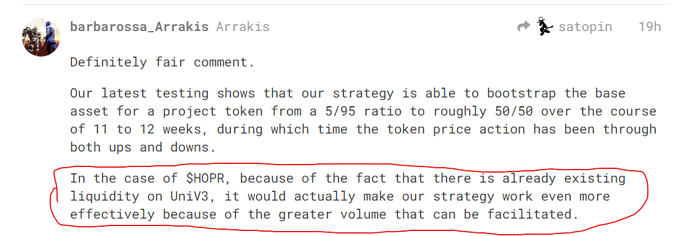Author: @bp_gamma
Hi HOPR Community!
I’m Brian from Gamma Strategies, which is an active liquidity manager on Uniswap v3. This forum post is mainly an introductory post to introduce our product offering and to discuss a potential liquidity solution.
We have been live on Mainnet since May 2021 when Uniswap v3 went live and are currently on all networks that support Uniswap. We’ve worked with DAOs/DeFi projects such as FWB, Liquity, Ribbon Finance, and THX to manage protocol-owned liquidity on their behalf.
Simple Summary:
Utilize Gamma Strategies and/or other v3 liquidity managers to manage HOPR liquidity on Uniswap v3 on Ethereum mainnet. Our suggestion is to manage all in one pool:
-
ETH / HOPR 0.3% OR -
DAI / HOPR 0.3%
Rationale:
Why ETH or DAI pairing?
ETH Pros:
- More correlated with HOPR, so a tighter range can be used with less impermanent loss
- ETH is the most paired asset on Uniswap, so pairing with ETH would allow for very efficient trade routing
ETH Cons:
- It’s a volatile asset pair, so the price of HOPR would likely be dragged up or down by ETH volatility
DAI Pros:
- Price stability - Pairing with DAI is essentially pairing to USD, so there’s less correlation with the volatility of ETH
DAI Cons:
- Less correlation with HOPR, means a wider range should be used to mitigate the effects of IL. This will increase price impact, but the status quo is full-range, so any concentration would be a net improvement in terms of price impact
- DAI is not paired with as many assets as ETH is, so there would be marginally less efficient routing
Why just one pool?
For the same reasoning as above, contributions to a single liquidity pool will do the most in terms of capital efficiency and lowering price impact on trades. A well-capitalized ETH / HOPR pool will contribute to the greatest number of low price impact trade routes given that ETH is the most paired asset on Uniswap.
Why the 0.3% fee tier?
The 0.3% fee tier is likely most appropriate based on the trade volume of the HOPR token, but 1% could also work if trade volumes stay at depressed levels. 0.01% fee tier is meant for stable-stable liquidity pairs. 0.05% pool is meant for semi-stable pairs such as ETH-wstETH or volatile pairs with high volumes such as USDC/ETH or WBTC/ETH. The current daily trading volumes are between $10K - $20K USD. Therefore, 0.05% or 0.01% would likely be ineffective in being able to generate enough fees to pay for gas fees to rebalance and would be subject to higher impermanent loss given the dearth of trading fees.
Technicals:
Gamma Strategies utilizes a position manager contract which takes in the base assets for liquidity and deploys those assets to Uniswap v3. The depositor (HOPR DAO) would be minted ERC-20 LP tokens representative of its liquidity position. Gamma runs automated scripts which will automatically rebalance the position when certain price targets are hit.
Business Model:
-
No upfront fees or management fees on the TVL
-
We charge 15% of the swap fees and gas fees for contract deployment + rebalancing
Specifications:
- Ranges: 25% and 400% of current price
- Rebalance triggers: 10% of the distance from current price to either lower or upper range
- Initial allocation of assets: 50% HOPR & 50% WETH
Benefits to Using Gamma:
- Automated rebalancing of the position within a more concentrated range than full range
- Better price impact control (See Appendix 1)
- By concentrating within a range of 25% to 400%, we can cut the price impact on a full range position in half
- No need to manage the position yourself or worry that the position will go out of range
Audits:
Gamma Strategies has been rigorously audited by ConsenSys Diligence and Arbitrary execution on March 28, 2022 and March 3, 2022 respectively.
Security & Safety
Managing liquidity solely on behalf of the DAO is much safer than managing liquidity vaults open to the public. We can assure that only the DAO has the power to deposit within to its own position manager contract.
Restricting the depositing of the liquidity only to the DAO prevents any flashloan attacks from happening as a result of an external 3rd party manipulating the token prices.
Gamma additionally has no admin function to withdraw any of the liquidity, and the DAO can deposit and withdraw from the vault permissionlessly.
The only admin function that Gamma would retain is the ability to rebalance the liquidity in the new range. But the vault would be completely noncustodial in that only the DAO would be able to deposit/withdraw to and from the vault.
Appendix 1: Price Impact Analysis**
- Red cells are inputs
- Concentrating liquidity within a 25% to 400% range will result in price impact of approximately 0.22% on a 10 ETH trade versus 0.45% on a full range position
Reference
Website: https://www.gamma.xyz/
Twitter: https://twitter.com/GammaStrategies
Discord: Gamma
Happy to clear up any questions or respond to anything with regards to this proposal! Thank you very much!
